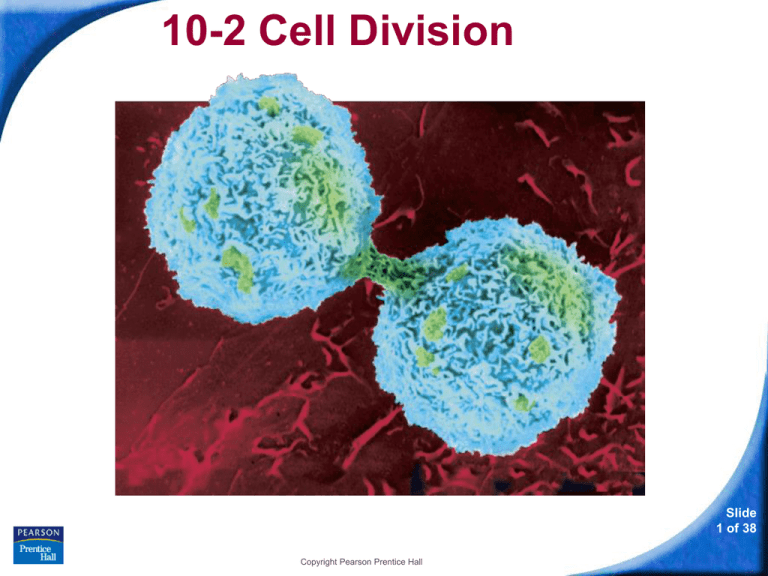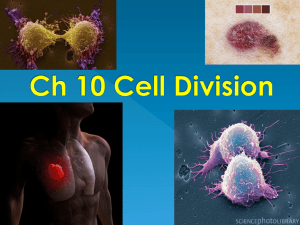
10-2 Cell Division
Slide
1 of 38
Copyright Pearson Prentice Hall
10-2 Cell Division
• In eukaryotes, cell division occurs in two
major stages.
The first stage, division of the cell nucleus, is
called mitosis.
The second stage, division of the cell
cytoplasm, is called cytokinesis.
Slide
2 of 38
Copyright Pearson Prentice Hall
10-2 Cell Division
Chromosomes
Chromosomes
• Genetic information is passed from one
generation to the next on chromosomes.
• Before cell division, each chromosome is
duplicated, or copied.
Slide
3 of 38
Copyright Pearson Prentice Hall
10-2 Cell Division
Chromosomes
Each chromosome
consists of two identical
“sister” chromatids.
Sister chromatids
Each pair of chromatids
is attached at an area
called the centromere.
Centromere
Slide
4 of 38
Copyright Pearson Prentice Hall
10-2 Cell Division
Chromosomes
When the cell divides, the chromatids
separate.
Each new cell gets one chromatid.
Slide
5 of 38
Copyright Pearson Prentice Hall
10-2 Cell Division
The Cell Cycle
What are the main events of the cell
cycle?
Slide
6 of 38
Copyright Pearson Prentice Hall
10-2 Cell Division
The Cell Cycle
The Cell Cycle
• The cell cycle is the series of events that cells
go through as they grow and divide.
• Interphase is the period of growth that occurs
between cell divisions.
Slide
7 of 38
Copyright Pearson Prentice Hall
10-2 Cell Division
The Cell Cycle
During the cell cycle:
• a cell grows
• prepares for division
• divides to form two daughter cells, each
of which begins the cycle again
Slide
8 of 38
Copyright Pearson Prentice Hall
10-2 Cell Division
Events of the Cell Cycle
Events of the Cell Cycle
• During Interphase the cell:
increases in size
synthesizes new proteins and
organelles
chromosomes are replicated
Slide
9 of 38
Copyright Pearson Prentice Hall
10-2 Cell Division
Events of the Cell Cycle
Cell Cycle
Slide
10 of 38
Copyright Pearson Prentice Hall
10-2 Cell Division
Mitosis
What are the four phases of mitosis?
Slide
11 of 38
Copyright Pearson Prentice Hall
10-2 Cell Division
Mitosis
Mitosis
Biologists divide the events of mitosis
into four phases:
• Prophase
• Metaphase
• Anaphase
• Telophase
Slide
12 of 38
Copyright Pearson Prentice Hall
10-2 Cell Division
Mitosis
Mitosis
Slide
13 of 38
Copyright Pearson Prentice Hall
10-2 Cell Division
Mitosis
Section 10-2
Spindle
forming
Prophase
Prophase
Chromosomes
(paired
chromatids)
Centromere
Click to Continue
Slide
14 of 38
Copyright Pearson Prentice Hall
10-2 Cell Division
Mitosis
Prophase
Spindle
forming
• Prophase is the first
and longest phase of
mitosis.
• The centrioles
separate and take up
positions on opposite
sides of the nucleus.
Centromere
Copyright Pearson Prentice Hall
Chromosomes
(paired
chromatids)
Slide
15 of 38
10-2 Cell Division
Mitosis
• The centrioles lie in a
Spindle
forming
region called the
centrosome.
• The centrosome
helps to organize the
spindle, a fanlike
microtubule structure
that helps separate
the chromosomes.
Centromere
Chromosomes
(paired
chromatids)
Slide
16 of 38
Copyright Pearson Prentice Hall
10-2 Cell Division
Mitosis
• Chromatin condenses
Spindle
forming
into chromosomes.
• The centrioles
separate and a
spindle begins to
form.
• The nuclear envelope
breaks down.
Centromere
Chromosomes
(paired
chromatids)
Slide
17 of 38
Copyright Pearson Prentice Hall
10-2 Cell Division
Mitosis
Metaphase
Centriole
Spindle
Centriole
Metaphase
Click to Continue
Copyright Pearson Prentice Hall
Slide
18 of 38
10-2 Cell Division
Mitosis
Centriole
Metaphase
• The second phase of
mitosis is metaphase.
• The chromosomes
line up across the
center of the cell.
• Microtubules connect
the centromere of
each chromosome to
the poles of the
spindle.
Copyright Pearson Prentice Hall
Spindle
Slide
19 of 38
10-2 Cell Division
Mitosis
Anaphase
Individual
chromosomes
Anaphase
Slide
20 of 38
Copyright Pearson Prentice Hall
10-2 Cell Division
Anaphase
Mitosis
Individual
chromosomes
• Anaphase is the third
phase of mitosis.
• The sister chromatids
separate into individual
chromosomes.
• The chromosomes
continue to move until
they have separated
into two groups.
Slide
21 of 38
Copyright Pearson Prentice Hall
10-2 Cell Division
Mitosis
Telophase
Nuclear
envelope
reforming
Telophase
Slide
22 of 38
Copyright Pearson Prentice Hall
10-2 Cell Division
Mitosis
Telophase
• Telophase is the
fourth and final
phase of mitosis.
• Chromosomes
gather at opposite
ends of the cell and
lose their distinct
shape.
Slide
23 of 38
Copyright Pearson Prentice Hall
10-2 Cell Division
Mitosis
A new nuclear envelope
forms around each
cluster of
chromosomes.
Slide
24 of 38
Copyright Pearson Prentice Hall
10-2 Cell Division
Cytokinesis
Cytokinesis
Cytokinesis
Slide
25 of 38
Copyright Pearson Prentice Hall
10-2 Cell Division
Cytokinesis
• During cytokinesis,
the cytoplasm
pinches in half.
• Each daughter cell
has an identical set
of duplicate
chromosomes.
Slide
26 of 38
Copyright Pearson Prentice Hall
10-2 Cell Division
Cytokinesis
• In plants, a structure known as the cell plate
forms midway between the divided nuclei.
Cell plate
Cell wall
Slide
27 of 38
Copyright Pearson Prentice Hall
10-2 Cell Division
Cytokinesis
• The cell plate gradually develops into a
separating membrane.
• A cell wall then begins to appear in the cell plate.
Slide
28 of 38
Copyright Pearson Prentice Hall
10-2 Cell Division
Phase Identification
Onion Root Tip - Interactive
Slide
29 of 38
Copyright Pearson Prentice Hall
10-2 Cell Division
PLANT CELL MITOSIS
Slide
30 of 38
Copyright Pearson Prentice Hall
10-2 Cell Division
1. Why is it more accurate to call mitosis "nuclear
replication" rather than "cellular division"?
2. Draw a plant cell in each stage of Mitosis.
3. What role does the spindle play in the cell dividing?
4. When and where does the cellulose wall (cell plate) form
in the mother cell?
5. How can you differentiate prophase from metaphase?
6. What cellular events occur during interphase?
7. How do the poles of the animal cell spindle differ from
those of the onion root tip?
8. Compare cytokinesis of animal cells with that of plant
cells.
9. What do you call the genetic information in each phase
of Mitosis?
Slide
10. Compare and contrast prophase and telophase. 31 of 38
Copyright Pearson Prentice Hall
END OF SECTION





